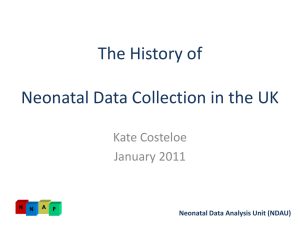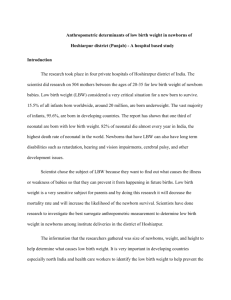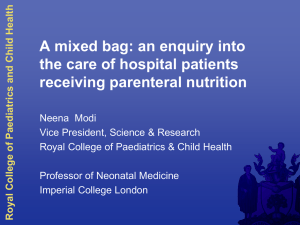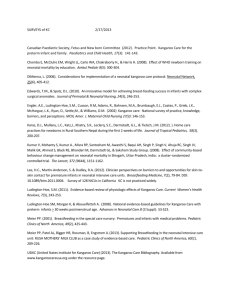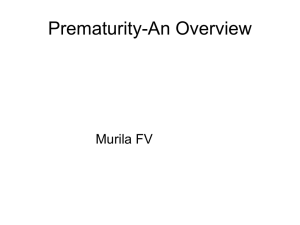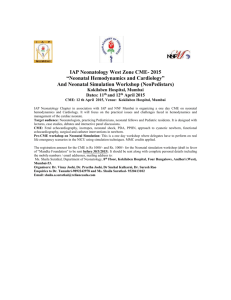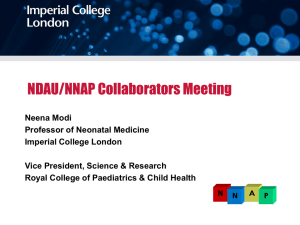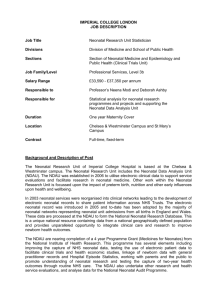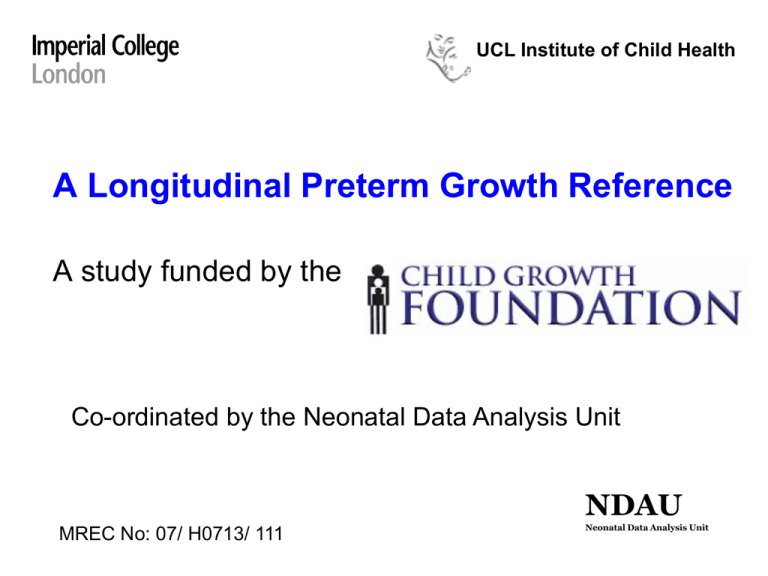
UCL Institute of Child Health
A Longitudinal Preterm Growth Reference
A study funded by the
Co-ordinated by the Neonatal Data Analysis Unit
NDAU
MREC No: 07/ H0713/ 111
Neonatal Data Analysis Unit
The Study Team
Investigators
Professor Neena Modi, Professor Tim Cole, Dr Huiqi Pan
Research Fellow
TBA
NDAU Manager
Mr Richard Colquhoun
Objective
• To construct a growth reference for weight, length and
head circumference in preterm infants ≤ 34 weeks
gestation from birth to term/near term
• Using routinely collected clinical data entered into the
Standardised Electronic Neonatal Database (SEND)
and related neonatal.net systems
A growth chart is series of
smooth curves representing the
distribution of measurements of
interest within a population
Content of growth charts
a) Type of anthropometric indices
eg weight, length, head circumference
b) Summary data
eg z-scores and percentiles
c) Population
eg boys, girls
Centiles and standard deviation score;
the bulleted points are two thirds of an SDS apart.
Cole TJ BMJ 1994;308:641-642
Is a neonatal chart a reference or a
standard?
• A standard represents optimum growth
(prescriptive)
• A reference allows the comparison of any one
individual against a population (descriptive)
History of preterm growth charts
In 1948 Dancis et al published the first
Preterm Growth Reference
Followed by:
1) Lubchenco et al (1963)
2) Battaglia et al (1966)
3) Usher and McLean (1969)
4) Babson et al (1970)
5) Brenner et al (1976)
Other Preterm Growth References
• Europe: Euro-Growth Reference; local (Brant 1976;
Excler 1987; Lozano 1998; Bertino 2006)
• Latin America: Gabriela (Chile 1989); Anchieta (Brazil
2004)
• China: Fok 2003
Growth reference charts used in
the United Kingdom
•
•
•
•
•
Tanner-Whitehouse
Buckler-Tanner
Cambridge
Harvard
Gairdner Pearson
• UK 1990 Reference
The UK 1990 Growth Reference
Based on cross-sectional data, utilising
birth weights, and therefore not suitable
to follow longitudinal growth
Study Methods
POPULATION
Infants born ≤ 34 weeks gestation
admitted to neonatal units using a
neonatal.net electronic newborn record
Standard Clinical Practice
• Maintain routine practice
• No extra procedures
• Measurements as clinical situation
permits
Variables
Anonymised data comprising:
a)
b)
c)
d)
e)
f)
g)
Gestational age
Sex
Ethnicity
Daily parenteral and enteral intake
Maternal details
Daily level of care
Weight, length and head circumference
measurements from birth to discharge
Statistical Analysis
The Cole LMS method will be used to construct
smooth curves summarising the distribution of
measurements by age and sex:
L = Skewness of distribution
M= Median of measurement
S= Coefficient of variation
Regulations and approvals
• Research Ethics approval obtained
• No patient consent required
• Site specific approval (SSA) exempt
• NHS Trust R&D approval necessary
• National Information Governance Board (NIGB)
approval not needed as data are anonymised
What is required from participating units?
• Nomination of 2 local co-ordinators
• Liaison with the Neonatal Data Analysis Unit (NDAU)
• Entry of high quality anthropometric measurements, at
a frequency determined locally
• We recommend no greater than weekly intervals
The NDAU office will
• approach your R&D Office on your behalf
to obtain Trust approval
• Local Principal Investigator not required
Anthropometric measurements
• Measurements taken by staff who have received training
• Recommend 3 repeat measurements if clinical situation
permits
• Head circumference measurement between the forehead
and the occiput with the hat removed
• Weight measured net of attachments/devices
• Length taken on a firm and flat surface by 2 people; 1
person holding the head whilst the other extends and hold
the feet against the foot rest
The neonatal.net record
Weight , head circumference and length
measurements can be entered on any given day
1)
2)
3)
4)
5)
6)
7)
Select Patient Name
Go to Patient Home Page
Select Patient Data
Select Daily Data (left hand column)
Go to Input Forms box
Click on Daily Details to load the Summary Data
Enter the new data (weight, head circumference & length) at
the top of the Summary
8) When complete, click Save and Close
Where are we now with the study?
To-date 77 UK neonatal units have
agreed to participate
Benefits of Participation
• Contribution to a national study
• The Child Growth Foundation will provide each
unit with newly designed equipment
• We will offer you on-site training in obtaining high
quality anthropometric measurements
References
• Freeman JV, Cole TJ, Chinn S, Jones PRM, White EM. Preece
MA. Cross sectional stature and weight reference curves for the
UK, 1990. Arch Dis Child 1995;73:17-24
• Cole TJ, Green PJ. Smoothing reference centile curves: the LMS
method and penalized liklihood. Stat Med 1992; 11:1305-19
• Growth reference charts for use in the United Kingdom. Wright
CM, Booth IW, Buckler JM, Cameron N, Cole TJ, Healy MJ, Hulse
JA, Preece MA, Reilly JJ, Williams AF. Arch Dis Child 2002;86:1114
Overview
The new longitudinal reference will provide
a unique tool for child health professionals
to assess the growth of UK preterm infants
The Research Office
For further information or queries please contact:
Mr Richard Colquhoun
NDAU Manager
Academic Neonatal Medicine
Imperial College London
Chelsea and Westminster Hospital
4th Floor, Lift Bank D
369 Fulham Road
London, SW10 9NH
T: 020 8746 5841
r.colquhoun@imperial.ac.uk


